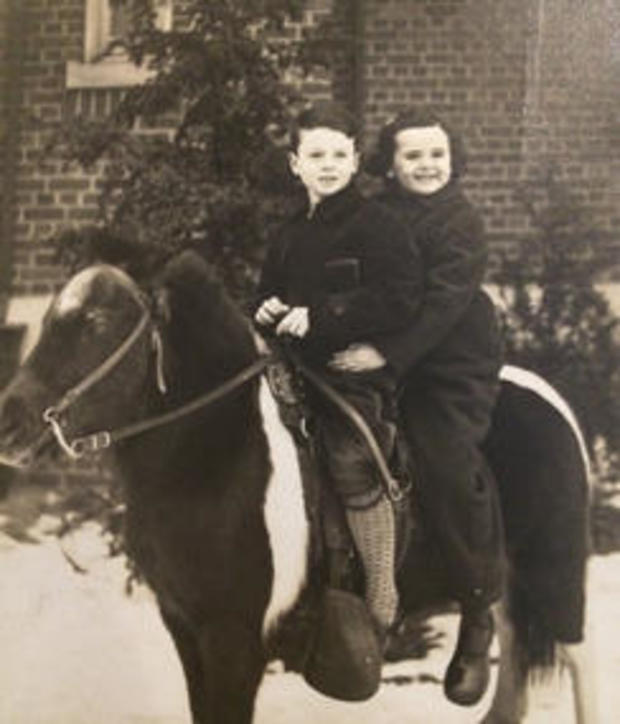Charles Osgood, Baltimore boy
Tracy Smith presents a page from our “Sunday Morning” Almanac:
January 8, 1933 ... 83 years, eight months and 17 days ago today ... the day Charles Osgood Wood was born in New York City.
He was joined just shy of a year later by his baby sister, Mary Ann, and together they shared a childhood of simple pleasures.
Summers meant happy times at their grandparents’ home in Massachusetts, where they whiled away the long days fishing and flying kites.
Back in New York, Charlie and Mary Ann shared a room in a small rental apartment ... and Charlie began his school days at Our Lady of Refuge in the Bronx.
That all changed in early 1942, when Charlie’s father, a textile salesman, was transferred from New York to Baltimore.
In Baltimore Charlie and his sister welcomed a much younger brother, Ken, and they experienced a unique period in our history.
And who better to tell THAT part of Charlie’s journey than
Charlie himself ... as he did right here on “Sunday Morning” back in
2005:
You leave the Pennsylvania Station
Around a quarter to four,
Read a magazine
And then you’re in Baltimore …
Baltimore, Maryland, birthplace of the great Babe Ruth and of the “Star-Spangled Banner.” Edgar Allen Poe lived there, and so did I.
The year was 1942. I was nine years old. Like many nine year old boys, I was in love with baseball, and radio … and the world around me.
And what a world it was, back then -- a world at war. A world of rationing, and air raid drills, and victory gardens, all of which seemed wonderfully romantic to a nine-year-old boy dreaming of the universe beyond Baltimore.
I can still see that boy in my mind’s eye, blissfully happy in that terrible time, as only a nine-year-old can be.
On January 2, a few days before I turned nine, the Japanese took Manila, and sadly I had to pin a tiny Japanese flag to the big map I had tacked to my bedroom wall.
It would be June 4th, the date of America’s great victory in the Battle of Midway, before I could happily pin up an American flag.
Did I mention that I loved baseball? The Orioles then were not the Orioles of today. In those days, they were a struggling AAA team that often played AA ball. I loved them anyway, especially when my father would take me out to the ball park to see the games.
In Baltimore in 1942, there were white wooden houses with big front porches and grand white stoops … many of them still standing, along with the Bromo Seltzer tower. It looked Italian with a distinctly American twist.
In those days, there was a 40-foot-tall Bromo Seltzer bottle on top of the tower. In Manhattan, a college boy met his date under the Biltmore clock; in Baltimore, they’d meet under the fizz.
In 1942, milk was delivered in bottles, the mail was delivered twice a day, and that boy named Charlie Wood had a paper route, delivering the Baltimore Sun.
Osgood demonstrated this throwing arm: “You’d have a stack of them held together with a strap, pull one out as you approach the customer, fold it into the throwing position -- this is where accuracy in journalism really comes in -- try not to get it in the bushes or on the roof.”
My best boyhood pal was a girl -- my slightly younger sister, Mary Ann, who followed the Orioles and the war, and loved the radio just as much as I did.
On an April day as misty as my boyhood memories, Mary Ann and I visited our old house on Edgewood Road and relived some of those childhood joys, like the gas street lamps.
“I don’t think we had one of those dishes on the roof in 1942,” Osgood said.
“No, we didn’t, but we got very good radio signals, though,” Mary Ann replied.
Radio was my window on the world -- and a world unto itself, a world more fantastic, and more real, than the world I saw every day in Baltimore … “The Lone Ranger” and Edgar Bergen, the only ventriloquist every to succeed on radio. I even knew what the Shadow looked like, and he was invisible!
American radio of the 1940s had a profound influence on me -- it’s the reason I am doing what I do today, instead of playing the organ at a skating rink. I could imagine no career more delightful, except perhaps to play shortstop for the Orioles. That dream was a little unrealistic, though -- I was afraid of ground balls!
In those golden days of radio, I never minded the intrusions of sponsors. The commercials were entertaining. Mary Ann and I both loved them.
If you want a peppy pup,
Than you better hurry up,
Buy Thrivo, for himmmmmmm!
I took piano lessons at the Peabody Institute, an august institution that’s still there in Baltimore, newly-refurbished and busier than ever!
Director Robert Sirota even had a surprise for me: “We even actually have your report card, Charles O. Wood, 3504 Edgewood Road. It says that you took four terms of piano satisfactorily.”
I still remember the song I played at my recital, “The Happy Farmer,” that I almost didn’t get to perform when they forgot to call my name.
In the evening, our family would gather around the piano at the house on Edgewood Road to sing our favorite songs. That was what families did in 1942, with the shades drawn and the lights dimmed in the midst of a terrible war.
For a few minutes, we’d let the rest of the world go by …
We’ll find perfect peace, where joys never cease
Out there beneath a kindly sky
We’ll build a sweet little nest
Somewhere in the west
And let the rest of the world go by.
